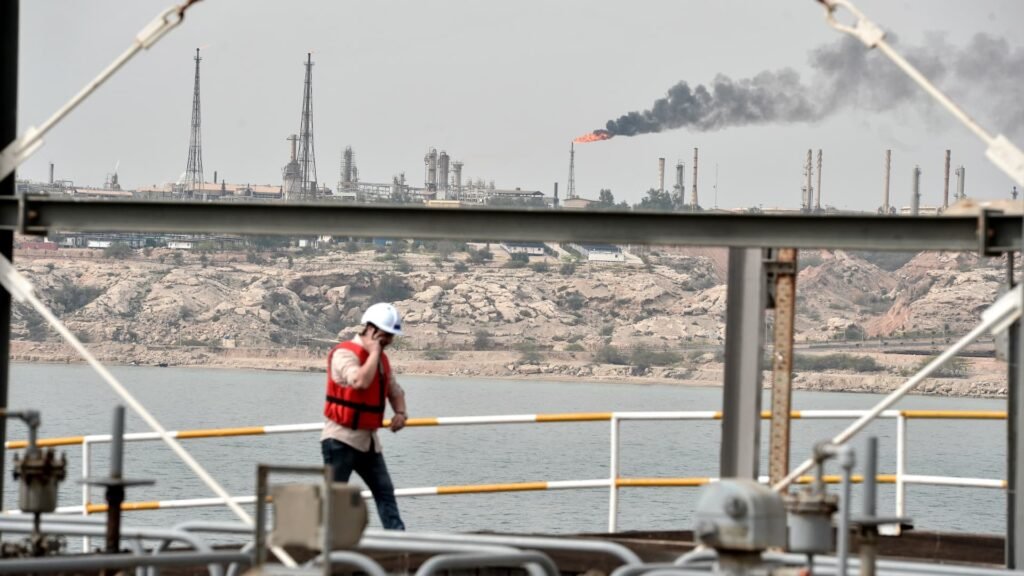Satellite imagery captured by the European Space Agency’s Copernicus Sentinel-1 mission on Sept. 25 shows a number of VLCC supertankers in the waters around Kharg Island, Iran’s principal oil export terminal.
This image contains modified Copernicus Sentinel data 2024 processed by Sentinel Hub
Satellite imagery revealed a number of oil tankers vacating the waters around Iran’s key Kharg Island oil loading terminal, amid fears of an Israeli counterattack on Tehran’s energy infrastructure.
“The National Iranian Tanker Company (NITC) appears to be fearing an imminent attack by Israel. Their empty VLCC supertankers vacated the country’s largest oil terminal, Kharg Island, yesterday,” tracking firm TankerTrackers.com wrote in a post on the X social media platform on Thursday evening.
Markets have been on edge over the possibility of Israeli retaliation, after Iran launched a missile attack against the Jewish state earlier this week.
Satellite imagery captured by the European Space Agency’s Copernicus Sentinel-1 mission on Sept. 25 shows a number of VLCC (very large crude carrier) supertankers in the waters around Kharg Island, Iran’s principal oil export terminal. VLCC tankers are specifically designed to transport large volumes of crude oil.
Imagery of the same location on Thursday — two days after Iran launched a volley of around 180 missiles at Israel for the killing of Hezbollah leader Hassan Nasrallah — shows an empty sea around Kharg Island, with no ships in sight.
Satellite imagery captured by the European Space Agency’s Copernicus Sentinel-1 mission on Oct. 3 shows an empty sea around Kharg Island, with no visible ships.
This image contains modified Copernicus Sentinel data 2024 processed by Sentinel Hub
CNBC could not independently verify the footage.
“Please note that crude oil loadings continue, but all of the extra vacant shipping capacity has been removed from the anchorage of Kharg Island. This is the first time we see anything like this since the 2018 sanctions round,” TankerTrackers.com added in a separate X post.
Iranian tankers are known for frequently switching off their transponders and manipulating their automatic identification system (AIS) in order to conceal their movements to skirt U.S. sanctions on the country’s oil exports. This is a different kind of development, says Samir Madani, co-founder of TankerTrackers.com.
His analysis of the satellite imagery located the Iranian tankers as currently being “in the middle of the Persian Gulf, west of the island,” he told CNBC.
Kharg Island: Iran’s largest oil terminal
Located 15 miles off Iran’s northwestern coast, the Kharg Island terminal handles more than 90% of the country’s crude exports. Its loading capacity has increased to 7 million barrels per day, according to Vesseltracker.com, although Iran does not currently export such levels.
Several energy analysts predict that oil prices could see an immediate-term spike of as much as 5% in the event of an Israeli attack on the terminal. Around 4% of global oil supply is at risk in the event of strikes on energy infrastructure in Iran, which is one of OPEC’s largest crude producers.
“There are plenty of facilities on [the] Iranian side and also [on the] Israeli side that could all be targeted in terms of critical infrastructure,” Sara Vakhshouri, founder and president of SVB Energy, told CNBC’s “Capital Connection” on Wednesday.

“That infrastructure is all connected,” she said, stressing that the sheer size of Iran means “it is impossible to somehow secure all of it.”
Crude futures are on track for gains of around 8% week to date, as markets await what Israel’s government has promised to be a “severe response” to the Iranian ballistic missile attack.
Oil prices jumped 5% on Thursday and are headed for their best week in more than a year following comments by U.S. President Joe Biden. Asked whether the White House would support retaliatory Israeli strikes on Iranian oil facilities, Biden on Thursday told reporters, “We’re discussing that. I think that would be a little … anyway,” breaking off mid-sentence.
The December delivery contract of global benchmark Brent was trading at $78.49 per barrel on Friday at 9:30 a.m. in London, up 1.1% from the Thursday close. The front-month November U.S. West Texas Intermediate futures were trading at $74.49 per barrel, higher by 1% from the previous day’s settlement.



